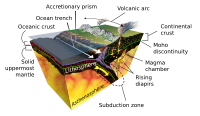
Photo from wikipedia
Key Points: Multibeam bathymetric and seismic reflection data image the structure of the North Chilean marine forearc and the oceanic Nazca plate The structural character and tectonic configuration of the… Click to show full abstract
Key Points: Multibeam bathymetric and seismic reflection data image the structure of the North Chilean marine forearc and the oceanic Nazca plate The structural character and tectonic configuration of the offshore forearc and the oceanic plate change significantly along the margin The derived pattern of permanent deformation may hold information for studying seismicity or other types of short term deformation New multibeam bathymetry allows an unprecedented view of the tectonic regime and its along‐strike heterogeneity of the North Chilean marine forearc and the oceanic Nazca Plate between 19‐22.75°S. Combining bathymetric and backscatter information from the multibeam data with sub‐bottom profiler and published and previously unpublished legacy seismic reflection lines, we derive a tectonic map. The new map reveals a middle and upper‐slope configuration dominated by pervasive extensional faulting, with some faults outlining a >500 km long ridge that may represent the remnants of a Jurassic or pre‐Jurassic magmatic arc. Lower slope deformation is more variable and includes slope‐failures, normal faulting, re‐entrant embayments, and NW‐SE trending anticlines and synclines. This complex pattern likely results from the combination of subducting lower‐plate topography, gravitational forearc collapse, and the accumulation of permanent deformation over multiple earthquake cycles. We find little evidence for widespread fluid seepage despite a highly faulted upper‐plate. An explanation could be a lack of fluid sources due to the sediment starved nature of the trench and most of the upper‐plate in vicinity of the hyper‐arid Atacama Desert. Changes in forearc architecture partly correlate to structural variations of the oceanic Nazca Plate, which is dominated by the spreading‐related abyssal hill fabric and is regionally overprinted by the Iquique Ridge. The ridge collides with the forearc around 20‐21°S. South of the ridge‐forearc intersection, bending‐related horst‐and‐grabens result in vertical seafloor offsets of hundreds of meters. To the north, plate‐bending is accommodated by reactivation of the paleo‐spreading fabric and new horst‐and‐grabens do not develop.
Journal Title: Tectonics
Year Published: 2018
Link to full text (if available)
Share on Social Media: Sign Up to like & get
recommendations!